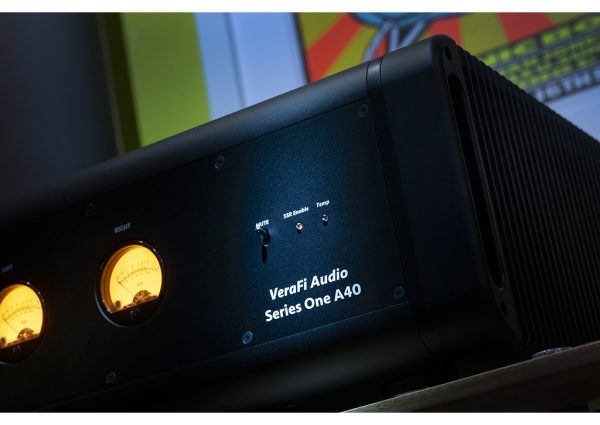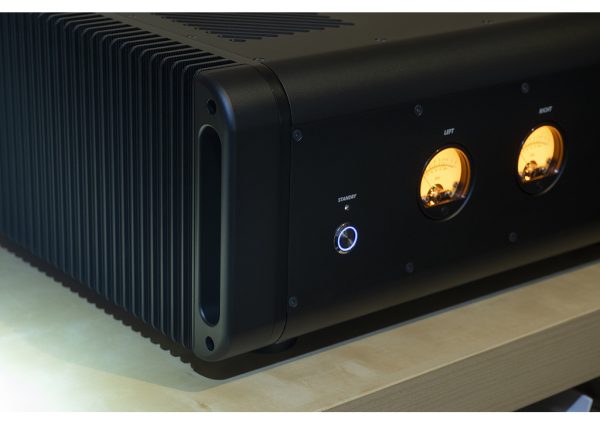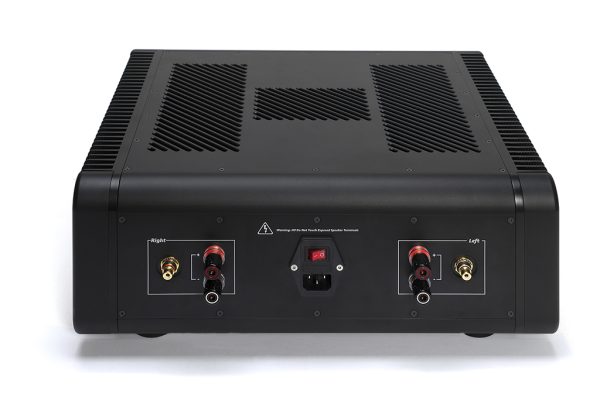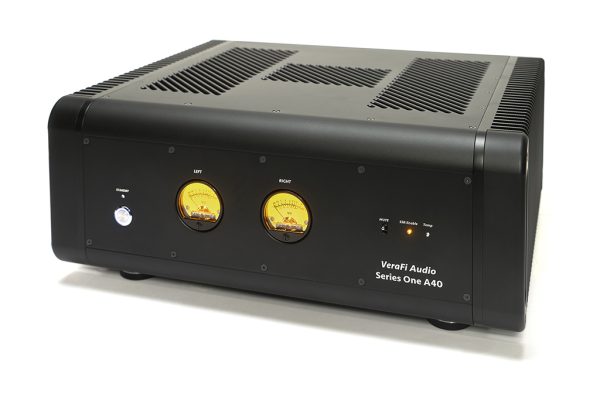The Vera-Fi A40 Power Amplifier – World’s 1st review! A luxurious low-power marvel
By Jeff Dorgay
It’s hard to believe that a $2,000 amplifier drives the $149k pair of Clarisis Auditorium Plus ribbon speakers with this level of control, quality, and tonal involvement.
Chris has me listening to Tool’s Fear Inoculum album more, and the track “Chocolate Chip Trip” has become a great test track due to its percussive, massive soundstage. Moving the A40 over to the Peak Consult Sinfonias ($68k/pair) proves equally involving. Even the new Magnepan 2.7X speakers ($10k/pair) deliver a lovely presentation with this small but weighty amplifier.
A 40-watt per channel amplifier can’t be everything for everyone, but the high level of sonic and aesthetic quality delivered here for $1,995 is incredibly impressive. Those familiar with Class A solid-state amplifiers know they generate a fair amount of heat and have a somewhat tube-like sonic characteristic, delivering a proportionately high degree of “that sound” without the inconvenience of selecting and replacing tubes.
The delicacy offered by smaller, simpler circuits is equally intriguing and tough to duplicate in higher-powered versions. We’ve had this experience with low-powered Class A amplifiers from Pass and Luxman. When talking to Nelson Pass about the XA25 and the XA30.8 power amplifiers we’ve recently reviewed (as well as their INT-25 amplifier), he makes it a point to say that the magic is tricky to scale.
It’s necessary to point out that the Alpha Nirvana amplifier making up the core technology of the A40 is a building block for Vera-Fi and their team, headed by Dr. Viet Nguyen (Lead Engineer), Jean-Paul Sweitzer, Darko Marinkovic, and Anthony Tuttle. But this is not the amplifier kit you can buy online for about 600 bucks; it’s much more. For those not familiar, Hugh Dean is the designer of the Audio Nirvana, so this is truly a global team project!
While we’re on that subject, the level of visual and aesthetic refinement that the Vera-Fi model brings is ace. This 50-pound amplifier is stunning in person, with fine detail in the machining and finishing, along with some integrated handles that are functional and attractive.

Much as I’d tell you to build one of these to get your hands dirty (I’ve got a Pass clone that I really need to get built one of these days, just because), DIY stuff usually looks somewhere between dreadful and scary when complete. This is an amplifier I’d be proud to have on the same rack as my Nagra tube preamp.
Vera-fi has made all the right choices in the A40s construction. Rather than trying to be everything to everyone and using substandard input transformers to offer a balanced input, Vera-Fi employs a single set of RCA input jacks and a single pair of Viborg copper 5-way binding posts for output. The inside reveals top shelf caps, careful wiring, and a pair of sizeable toroidal power transformers. You’ll either love or hate the yellow, backlit VU output meters, but I’m a fan. Those meters are the only aesthetic frivolity present.

Setup
As with any Class-A amplifier, the A40 runs very warm once on for about an hour. It offers good sound out of the box, but everything stabilizes somewhere between 50 and 100 hours. Because of the increased power draw of the Class A circuitry, you probably won’t want to leave everything on 24/7. Complete warm-up occurs around 45 minutes, and the amplifier sounds a little foggy right after powering up, but it goes away.
While the A40 was placed front and center, being fed by the Pass Labs XSPre line stage, dCS Vivaldi ONE Dac/streamer/player, and driving some pretty major speakers, this shows precisely how much resolution it has compared to other amplifiers at similar and substantially higher price points.
You aren’t getting a pair of $90/K Pass monoblocks for $2k, but you are getting an incredible amount of sonic goodness for the price. In terms of sheer musicality, this robust little amplifier delivers nuance and detail that many far more expensive solid-state amplifiers can’t. But remember, 40wpc. So choose your speakers wisely.
The overall sound
Fans of Class-A designs will feel at home with the A40. The soundscape is expansive, the highs liquid and non-electronic sounding (i.e. lack of grain, edginess, and fatigue), with a midrange musicality better than many (more expensive) non class – A solid state amplifiers.
As with all great Class-A solid state amplifiers, those of you who love music featuring solo vocals, and heavy on the acoustic instruments will have a lot to explore. However, if you have speakers with enough sensitivity (like the ZU DWRs in for review right now) you should be able to really raise the roof. I’ve gotten in line to purchase an A40 because I’m always looking for great building blocks to assemble systems at all levels, and I suspect this amplifier will provide brain-damage volume levels when I get my hands on those vintage Klipschorns calling out to me across the I-5 bridge at Echo Audio.
With all speakers used for the demo, the bass is extended and controlled. Better than tubes but not quite as much as a higher-powered Class-AB amplifier. This holds true for every other brand of solid-state amplifier I’ve used, so no disrespect to the A40. Even when using the MartinLogans with a pair of passive woofers, all my favorite bass-heavy tracks deliver the goods.
Best of all, this amplifier is free of fatigue. Even when playing it 24 hours a day for the first week with the Peak Consult speakers, this is an amplifier you can listen to forever without it getting on your nerves. I know this is what has always drawn me to Class-A solid-state designs. The overall sound is slightly warm, not as warm as a Pass labs amplifier, and much less warm/lush than a Luxman or Accuphase class A design. In addition to the dynamic drive this amplifier offers, clearly evident on your favorite heavy rock tracks, the A40 brings so much inner detail and depth to your favorite tracks that you’ll be wondering how you did without it.
It may be old age and fondness taking advantage of me, but the A40 channels my old Mark Levinson ML-2 amplifiers in the way it presents music. After my A40 arrives (get your order in now, there are only a few left of the first batch, and they are taking $500 pre-orders for the next production run) I’ll find a pair of ML-2s to get in for comparison?
Appropriately paired
Keeping the A40 in context with the gear I’d probably pair it up with if I were building a system for about 10-15k is a home run. An out-of-the-ballpark, across the fence, into the parking lot home run. Using an older ARC SP-9 preamplifier (about $900 – used), the Naim CD5is CD player (about $2k new), a used SOTA Sapphire turntable (again about $1,500) along with the Harbeth Monitor 30 speakers, Magnepan 2.7X speakers, and the Vera-Fi Vanguards. Altogether, these Legos were combined to build systems worth about $6,000 to about $20k.
It’s also worth mentioning that the A40 does an excellent job driving the MartinLogan ESL9s we have on hand. If you have a pair of MLs around, this can be your amplifier, too, if you don’t need to blow the windows out. Great success was had with my vintage Acoustat 2+2 ESL speakers, so this might just be a FAB amplifier to pair up with a pair of Quad 57s too. Finally, the A40 perfectly matches the new SVS Ultra Evolution Towers. We’ve got a pair of those in on review, too, and their highly resolving diamond tweeter might be a bit too much for some, but the combination of the modestly mellow A40 and the up-front SVS speakers is a killer combo.
In conclusion, the A40 is an excellent anchor for a sub-$20k hifi system without having to go used or DIY. While you can’t bridge them (again, there goes the magic), using a pair of these in a vertical biamp type system could be incredibly good for those craving more dynamic headroom.
The A40 delivers so much performance for the money the only reasonable comparison I could come up with was the PrimaLuna EVO 100. At about $2,600, this 38 wpc tube amp is equally robust but very different. Of course, the tube amp has even more tonal saturation, especially the midrange – but the tubes don’t control the bottom end as succinctly as the A40 does. Highs are different in presentation, with the A40 being more resolving and the EVO 100 being more silky smooth.
These two power amplifiers represent the best values going in a low powered tube or solid-state amplifier period, end of story. Some of you will have to have tubes, while others will insist on solid-state. If you’re on the fence, I suggest the A40 because you’ll never have to replace tubes.

Wait for it
Sometime next year, Vera-Fi will produce a matching preamplifier to go with the A40, and if you like all your components to have similar form factors, I suspect this will be a nice addition.
Affordable, high-performance solid-state has a new advocate. Not to be missed. Please click here to go directly to the A40 on the Vera Fi site. All the pertinent specs are here too.



